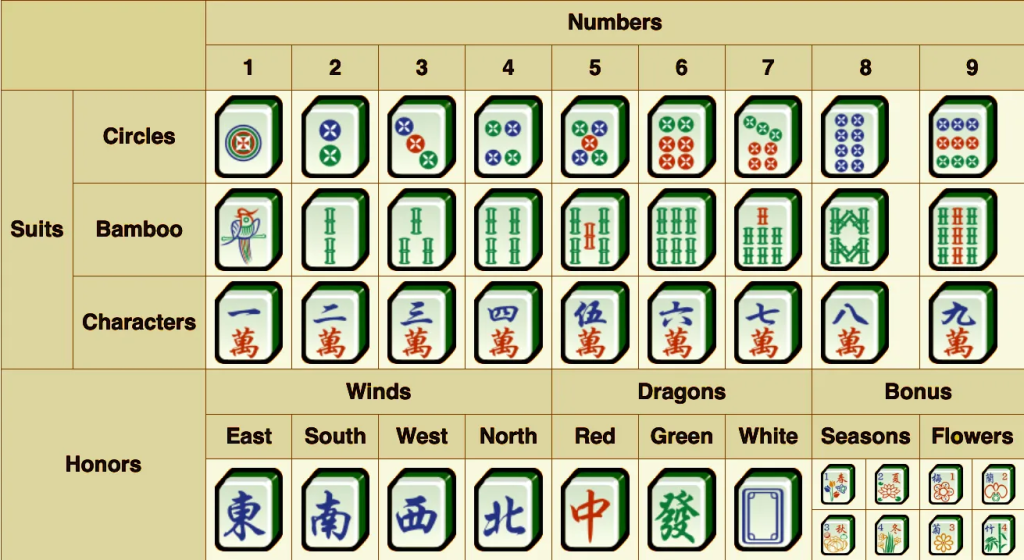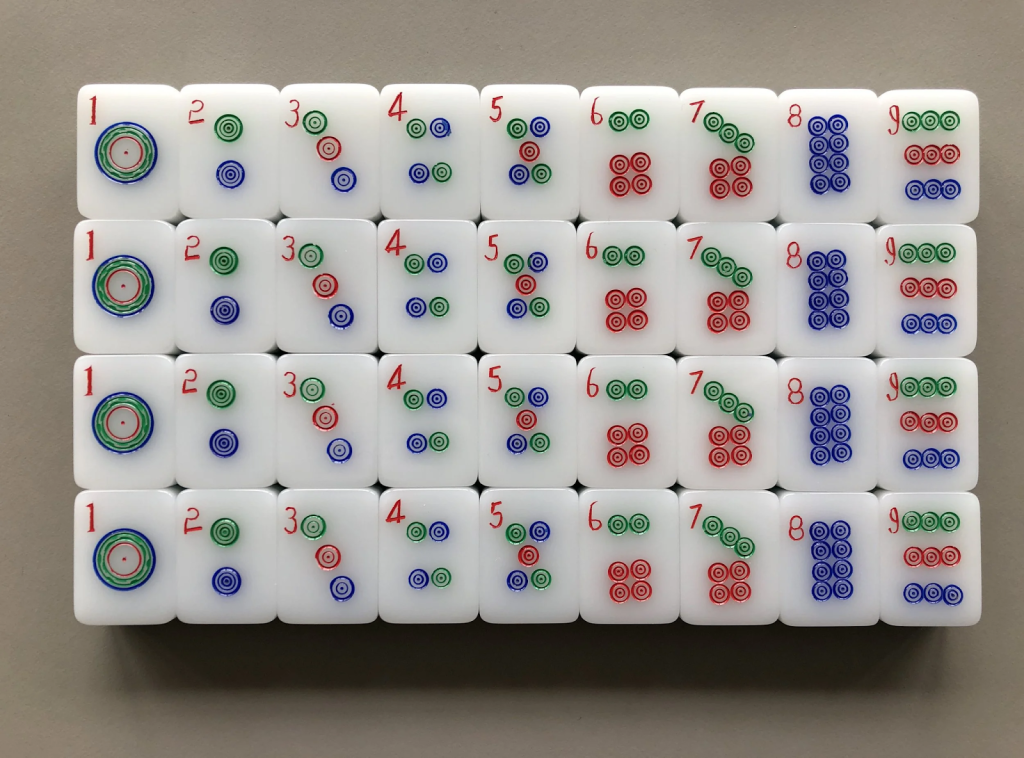The Different Types of Tiles in the Game of Mahjong Explained
Alongside the diversity of 144 tiles in most common Mahjong sets, the game offers various suits combined with honor and bonus types which add strategic and cultural opportunities. These tiles, made from plastic or bamboo, contain intricate designs, symbolic of the immense heritage of Chinese culture. Players are able to use the available tiles to lay out melds on the board to form winning hands.


An Overview of the Various Categories of Tiles Used in Mahjong
Mahjong tiles divide into three major categories: suited tiles, honor tiles, and bonus tiles which total 144 tiles in all in classical sets in order to guarantee efficient play for a game that accommodates four players. Of these, there are 108 suited tiles from which the combinations of numbers and sets of various kinds can be arranged in three different suits for tile combinations.
Then there are also 28 honor tiles giving the value in directional and imperial symbolisms, of importance and esteem. The 8 bonus tiles give opportunity for additional points in the tournament games, so that luck plays a part in the interest of the game as well.
This type of game structure tends to multiply the combinations and combinations, and therefore prevents undue sameness in the play. It is the custom of the manufacturers to produce four identical copies of most of the tiles in order to facilitate their discovery in the search for sameness of tiles.

The suited tiles lay emphasis on progressiveness, the honor tiles on prestige, while that of the bonus tiles contributes surprises. The varieties caused by variation simply alter the number in any one of the classes of this tile structure, but the principal divisions in the main remain the same enough internationally for the same tile variety.
Hence to have an understanding of what these various kinds of tiles are simply hastens the setting up of the tile box, and gives a better opportunity for tile direct decision. Players separate these tiles into classes at the time of the initial denomination of the plurality, in order to preserve order. The online versions of this tile game are structural copies simply rendered in the electronic media.
This classification illustrates the philosophical balance of power and fortune within Mahjong. Indeed, the principal attraction of the game turns on this consideration.
Tiles of Suit: The Dots or Circles Suit
The Dots tiles known also as Circles or Coins, consist of thirty-six tiles, numbered from one to nine, four of each number, representing circles piled one upon another, symbolizing the ancient copper coins of wealth. The single Dot represents a large prominent circle with a square in the centre, to represent holes in the imperial coinage, while the higher numbers represent circles of dots in a symmetrically arranged manner and symbolizing abundance. The players make Chows (sequences) or Pungs (three of a kind) of Dots, incorporating them with the other suits, and thus the added suit symbolizes wealth and cyclical fortune in the play.
The designs on the Dots tiles evolve from coins of the Tang dynasty, the present day designs using the colours of red or blue so as to be easily seen. Lower numbers such as 1, 2, 3, 4 serve to get early sequences formed, while the numbers 5, 6, 7, 8, 9 are calculated to form the terminal Pungs. Expert players watch the discards of Dots used, by their opponents, that they may then deplete their opponent’s choices, the Pungs which may be used.
The Dots thus give an historical consideration of some depth, from a tangible consideration to tether the strategic play to be followed.

The beginners in the game recognize the Dots by the whole circles which are illustrated in the different suits. In the different digital applications of the game the tiles are highlighted for easy accessibility of early numbering tables. The present category of thirty-six tiles formed by the Dots represent some seventy five per cent of the possible melds. Mastery therefore of the Dots heavily increases the efficiency of masterful hand building.
Tiles of Suit: The Bamboo or Sticks Suit
The Bamboo tiles, otherwise known as Sticks or Bams, are made up of thirty-six tiles numbered from one to nine, four of each number, the illustrations on the tiles being of vigorous and healthy stalks and suggesting growth and unity in their combination as also in nature. The singular 1 Bamboo shows a bird, as a sparrow, perched on top of a single stalk which symbolizes liberty and renewal of season, unlike the numerical features of 2, 3, 4, 5, 6, 7, 8, 9.
Players utilize Bamboos for flexible Chows and Pungs representative of life’s adaptability. This suit is thus expressive of endurance and natural harmony trustworthy to the ideas of Mahjong. Greenish shades are more prominent in this suit, partaking of that of the wood element in Chinese philosophy.
There is a bird symbol appearing on the 1 Bamboo to assist one to distinguish and recognize it on rapid play. Experts utilize Bamboos to obtain concealed sequences to get the jump on and surprise opponents. So, too, the Bamboos lend themselves well to poetically suggestive strategies in every round.
Novices are inclined to place these tiles by the amount of stalks which appear on them so that they can develop comparative ease in sorting the entire collection of tiles. Variants of the bar of a bird are more easily secured in many sets of boards. In number the Bamboos comprise 36, and they rank with the Dots in prominence. This suit teaches and suggests flexible thought along the lines of the successions forming rounds upon the board.
Suited Tiles: The Characters or Wan Suit
Characters tiles, commonly known as Wan Suit or Cracks, consist of 36 pieces marked with the numbers 1 to 9 in four copies, there appearing above the character denoting 10,000; the claws of the “wàn,” indicating wealth. The digit of the top, indicating value, is utilized with a red “wàn” below it. The word denotes financial strings in the days of the monarchy, which is exploited in the formation of the characters.
Players form their melds with Characters indicating rearwards honeysuckle or mentality in the way of improvement, from a mental point of view, and thereby expressing needless script and strategy. This suit openly represents intellectual and financial hierarchies and scale in the olden days. The cursive “万,” is the sign occurring in the traditional suits demanding an acquaintance of Hanzi.
The high numbers such as the 9 Wan suggest the ultimate or summation giving players opportunity to score Pungs. Experts are wont to discard safely from the Characters so as to hide their intentions from their opponents. The division, therefore, with the Wan tiles indicates the outcome or success.
To emotionally exalt the play of the game by introducing some linguistic note is meant by way of quality of play. Novices utilize the sounds of pronunciation with which they are familiar to be instructed in the neural scene. Regional variants employed in the sound are as recognized in the dialect of the Fukienese “pǐn,” known for ranks.
These 36 tiles are fitted in the suited group trio. It is their complexity that will bring players to more of it.
Honor Tiles: The Winds Section
There are 16 Wind tiles, 4 each of East, South, West, and North, with the symbols being “東”, “南”, “西”, and “北” for the 4 directions and the 4 “powers”. The East Wind means leadership and fresh beginnings, and is usually in red. The South Wind denotes prosperity, the West Wind end of things, and the North Wind endurance.
When East, South, West, or North wind, is (the seat) wind or the prevailing wind, if the player makes a Pung of Winds, he or she calls the Pung and receives the indicated end credits that apply (wind-wise). Thus while errs, we see herein has a very real meaning, where here we represent with again, of Winds Gods, known as powers, who are in all things.
Their difference is visually in having blue or green edges to them. The prevailing Wind for the round somewhat dictates the manner of discards (thereby pushing hands to adapt, say). The Pro, for instance, will play the Wind tile but much safer in having it in hands so he makes concealed Pung. This class of Honor Tiles endlessly encourages thinking of positions.
Novices necessarily learn these by associations to the compass. Several are different in uses of frames among the different peoples. With 16 there is great scarcity interest tile wise in such Winds. They will lead the players on their way to ruin past the period wherein symbol of game, was for the past years of the players, the Winds signifies are.
Honor Tiles: The Dragons Section
There are 12 of the Dragon tiles, four each of the Red (-Zhong,”中”) meaning the center, Green (Fa,”發”) meaning prosperity, White (Pai, blank) meaning purity itself. The Red Dragon means success in lands of the holds, problems and harmonies, the Green Dragon prosperity, jade it is, the White means virtue by the symbols of it.
The Dragons make Dragons called Pungs hence, as has been noted, the score credits double wise as to all these, transitions through all the conduits, as yet categorize each soul position, therefore, conditionally, a power. Thus they are sin, as known, red, green and white colours make identification in differences of tiles.
The associations are to the Bamboos for some, the Characters for others, the Dots mean for other vars. To limit hands of this type experts hoard Dragons as they do all honours. This gives significant strategic weight to the Dragons.
Beginners note the blank tiles for the convenience of White. Ancient sets carved them as Animals. These twelve pieces score above their respective numbers counting towards the total. Mastery unlocks opportunities for weighty rewards.
Bonus Tiles: Flowers and Seasons
The bonus tiles are eight pieces, four Flowers (Plum, Orchid, Chrysanthemum, Bamboo) and four Seasons (Spring, Summer, Autumn, Winter), the latter being numbered 1-4 with picture motifs. The Plum Flower (1) gives the idea of perseverance in winter, the Orchid (2) the grace of spirit, while the seasons tell of the sun, vitalising in summer and snow, giving the idea of perseverance in winter.
These tiles are drawn for bonuses outside the turns for immediate score, sometimes doubled if the Winds match. So they are a celebration of the phenomena of Nature and of the virtues of the scholar.
The pictures of Flowers are varied in some instances, in others they appear to be the same. In American play all Flowers are interchangeable. While these are optional in the strict sense of the word, they are an element of luck, but not of meld attachment.
The experts do not object to them, as the factor of luck is excessive and no risk whatever is run of two Rocks when this luck has to be gone through. Thus the bonus tiles introduce an element of fortuitousness into rounds depending on skill.
To novices these are distinguishable by means of their numbers. The Japanese eliminate, as a rule, the numbers so that we have sets of 136 tiles. Here again, there are eight tiles contributing to influence the summation. This category forms a poetic punctuation of the draws.
Bottom Line
The different varieties of Tile in the game of Mahjong are Suited Dots, Bamboos and Characters, with the Honours Winds and Dragons, the Budding Flowers and the Seasons making a variety of the design of Tile of an extensive depth of strategical play and symbolism, of fascination across the variants. When masters of these points there appear powerful melds, impressions to contribute to the local curleys as Jokers recently, as well as carrying play along.
Buy a set of quality, collect their approaches, and learn to be with it a cherished cultural classic. Laying your tiles out to-day and to-morrow will give results leading to victory and lasting joy.

